Not long after moving here I planted a trial of bearded iris. I’d been inspired to do so by our hot, south-facing slopes and the possibilities that came with having space. At the time I was also in the process of replanting a
Lutyens and Jekyll Arts and Crafts garden for a client. The iris felt right for the period when the garden had been in its heyday, so I made a research trip to
Woottens of Wenhaston to see their famed collection. Their extensive fields fluttered with hundreds of varieties, which were thrown together as far as the eye could see. It was an unforgettable moment. Even with the exercise of some restraint, I still came away with a list of fifty-six that I wanted to trial.
Of those divisions that arrived bare-root in their period of summer rest that July, three plants were of Benton heritage. I did not know it then, but the Bentons have refocussed and refined my iris eye. It is only when you grow plants for yourself that you get to know the best for your purpose and your true favourites. The trial revealed varieties that I had been seduced by in the field, but that in truth were easy to part with. And I
did part with a lot. I was interested to find that of all the colours trialled it was the dark blues and purples, the colours with which bearded iris are perhaps most commonly associated, that looked most out of place in the landscape. I also dispensed with all those that felt overbred, with too much flounce, frill or rigidity to give the flowers real grace. However, once our focus fell upon the sophistication of the Bentons and we started to seek out more, the trial grew as quickly as it shrank.
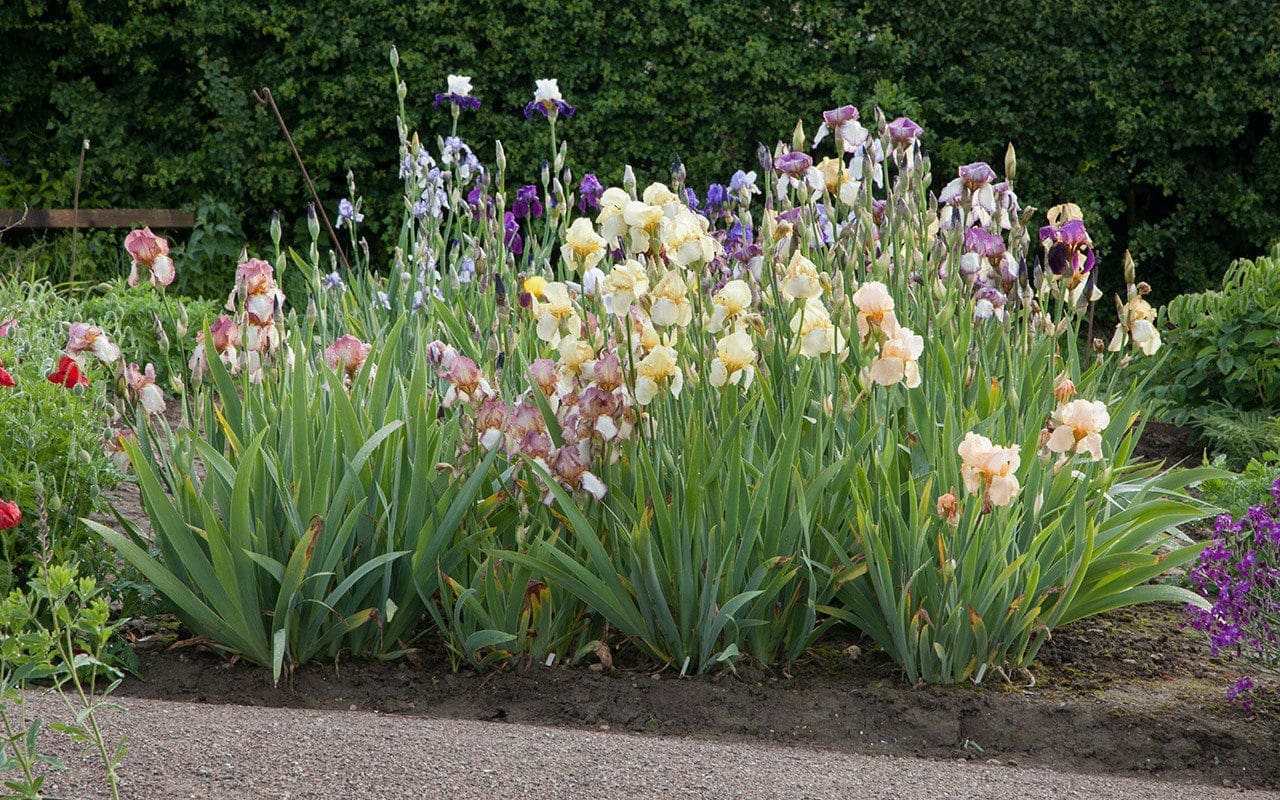 The iris trial bed in full flower in early June with the Bentons in the front
The iris trial bed in full flower in early June with the Bentons in the front
The Benton iris were bred by the artist and plantsman
Cedric Morris at his home Benton End in Suffolk. Between 1934 and 1960 he raised thousands of bearded iris from seed, selecting some of the first pink, peach and yellow varieties that were widely acclaimed at The Chelsea Flower Show. Regularly growing as many as a thousand seedlings a year he named around 90 varieties, the greater majority of which have been lost to time as they went out of fashion or were left behind and then, as gardens changed hands, overwhelmed or their provenance forgotten. As timing would have it,
Sarah Cook, the previous head gardener at Sissinghurst, had also fallen under their spell and had made it her mission to pull the lost collection together. She teamed up with Howards Nurseries and together they mounted one of the best stands in the Great Pavilion at the
2015 Chelsea Flower Show. Thanks to Sarah and her tireless hunt and research, twenty five or so are now available again and her quest to find still more is ongoing.
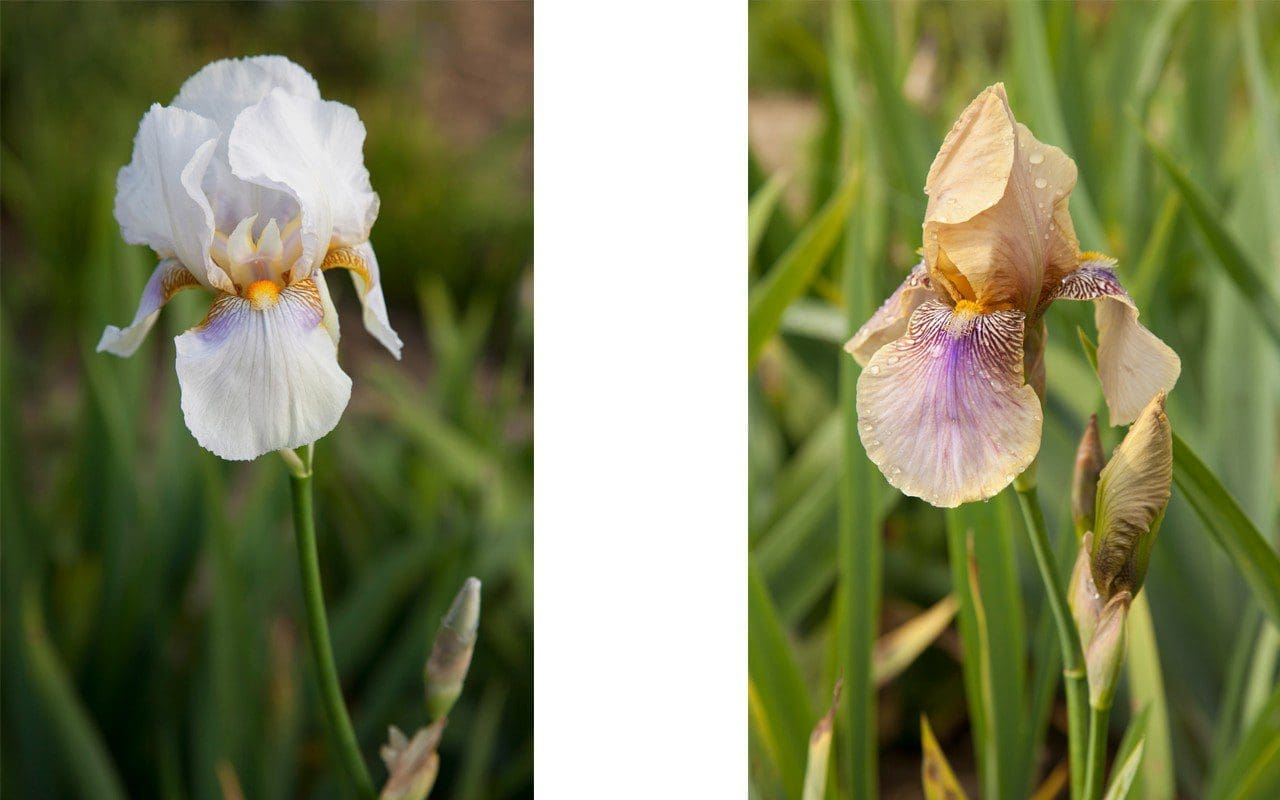 Iris ‘Benton Pearl’ and Iris ‘Benton Olive’
Iris ‘Benton Pearl’ and Iris ‘Benton Olive’
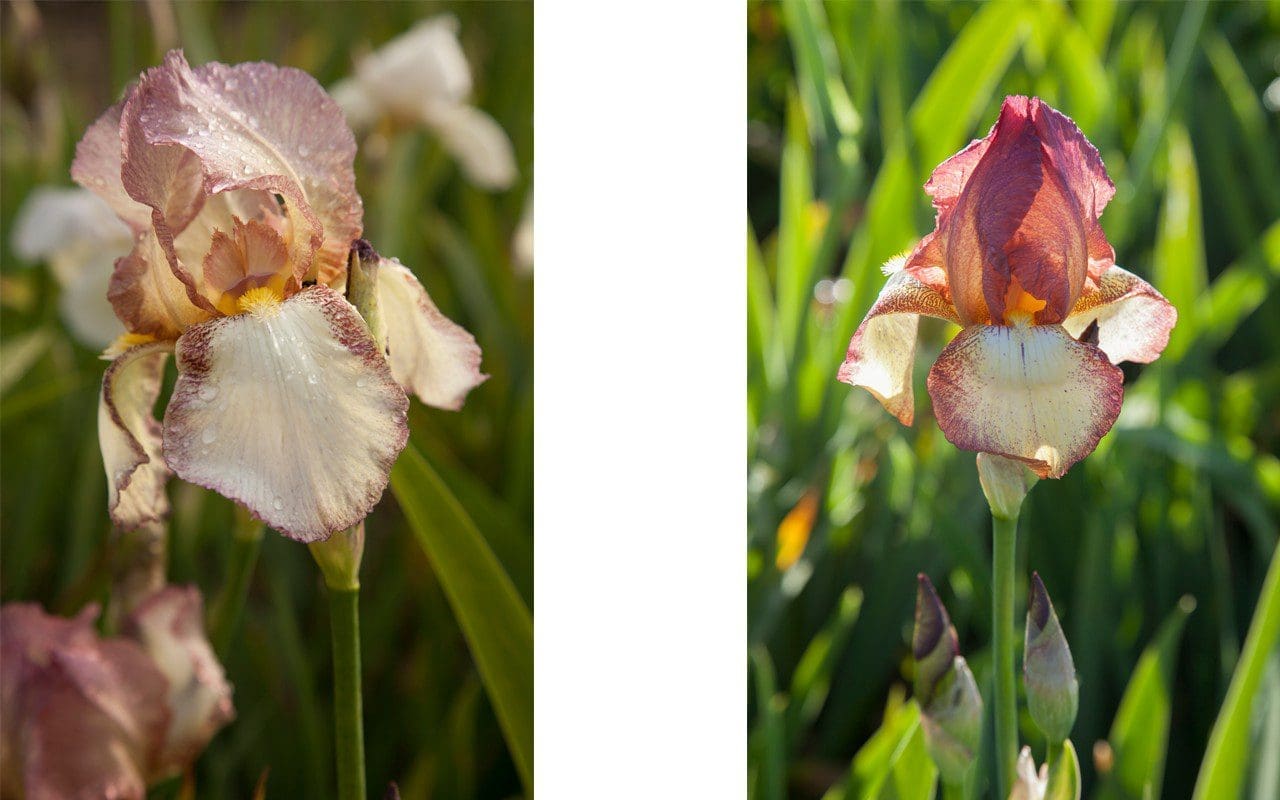 Iris ‘Benton Deidre’ and Iris ‘Benton Arundel’
Iris ‘Benton Deidre’ and Iris ‘Benton Arundel’
I would love to have met Morris, for he obviously had an incredible eye and nose for a flower with poise, grace and perfect balance, despite its complexity. Thanks to his eye, I have now been able to strip the trial back to my true favourites, which include 20 of his selections and just a handful of others that feel right alongside them; chestnut brown ‘Kent Pride’ was bred in the ’50’s and has the same period feel, while the straw yellow ‘Glen Ellen’ is as graceful in form and unusual in its colouring. The only blues I have kept are pale and refined; the small-flowered picotee, ‘Madame Chereau’ and the ice-blue and white ‘Nassak’. Of the purples ‘Demi-deuil’ almost looks like a species iris with small, dark-veined flowers, while the truly almost-black ‘Anvil of Darkness’ was always a keeper, because to my eye no other iris has such depth of colour combined with such a light and refined flower form.
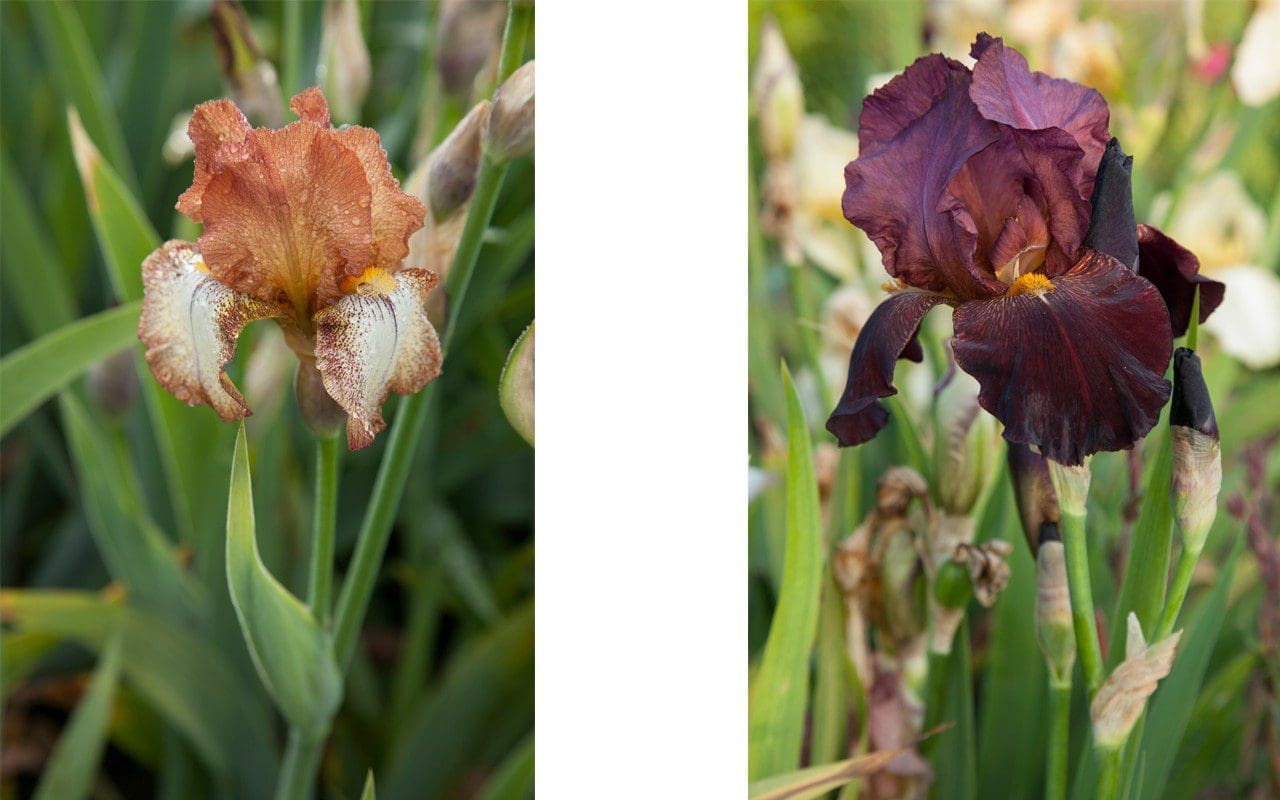 Iris ‘Benton Nutkin’ and Iris ‘Benton Caramel’
Iris ‘Benton Nutkin’ and Iris ‘Benton Caramel’
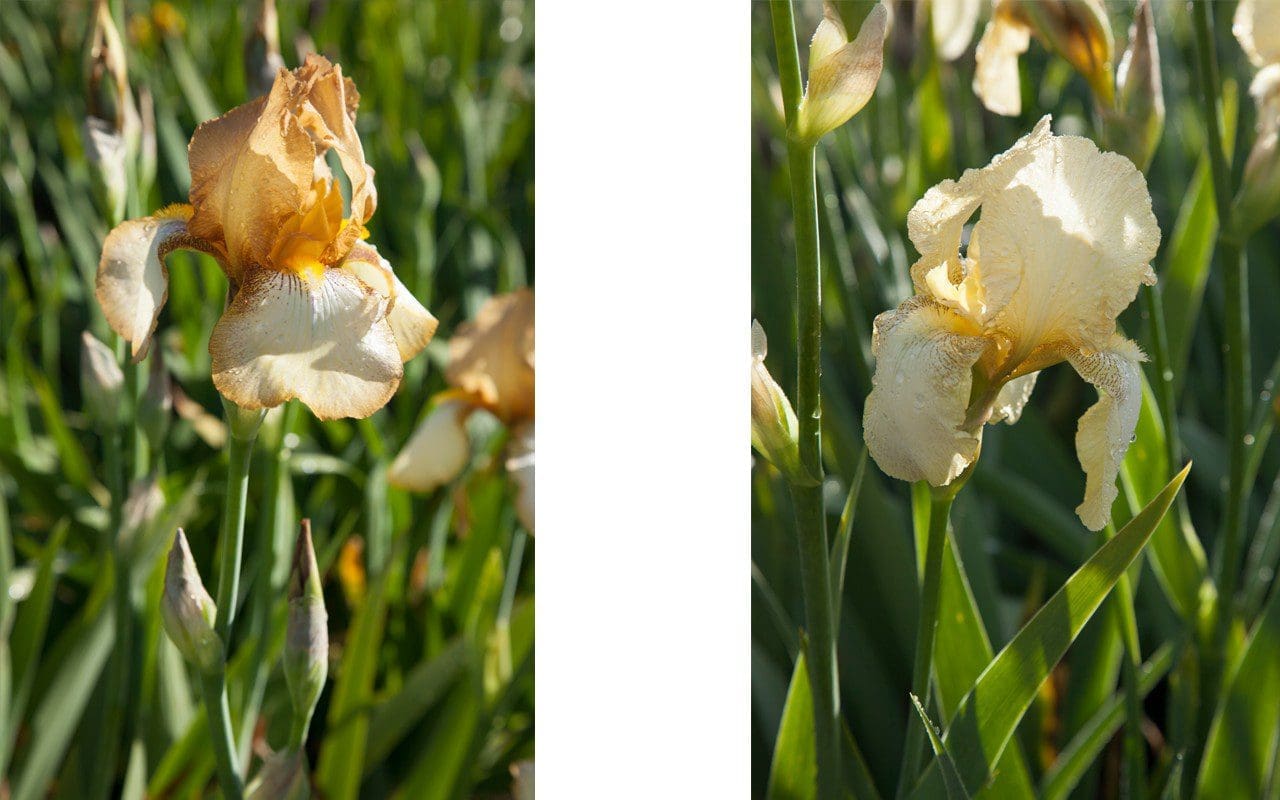 Iris ‘Benton Susan’ and Iris ‘Benton Duff’
Iris ‘Benton Susan’ and Iris ‘Benton Duff’
The Bentons have their own particular beauty which is hard to put your finger on, but you know it when you see it. With more elongated flowers and space between the falls they have an ethereal, stately quality. There is a bruised, sophisticated complexity of colour, which conjures another period and you can see is the result of an artist’s eye; picotees in shades of plum, mauve and pink, silver grey, mother-of-pearl white, primrose yellow, true apricot, rich chocolate brown and papal purple. You completely trust in Morris’s eye when you see them and his choices were so particular that you can almost feel what it might have been like to know the man himself.
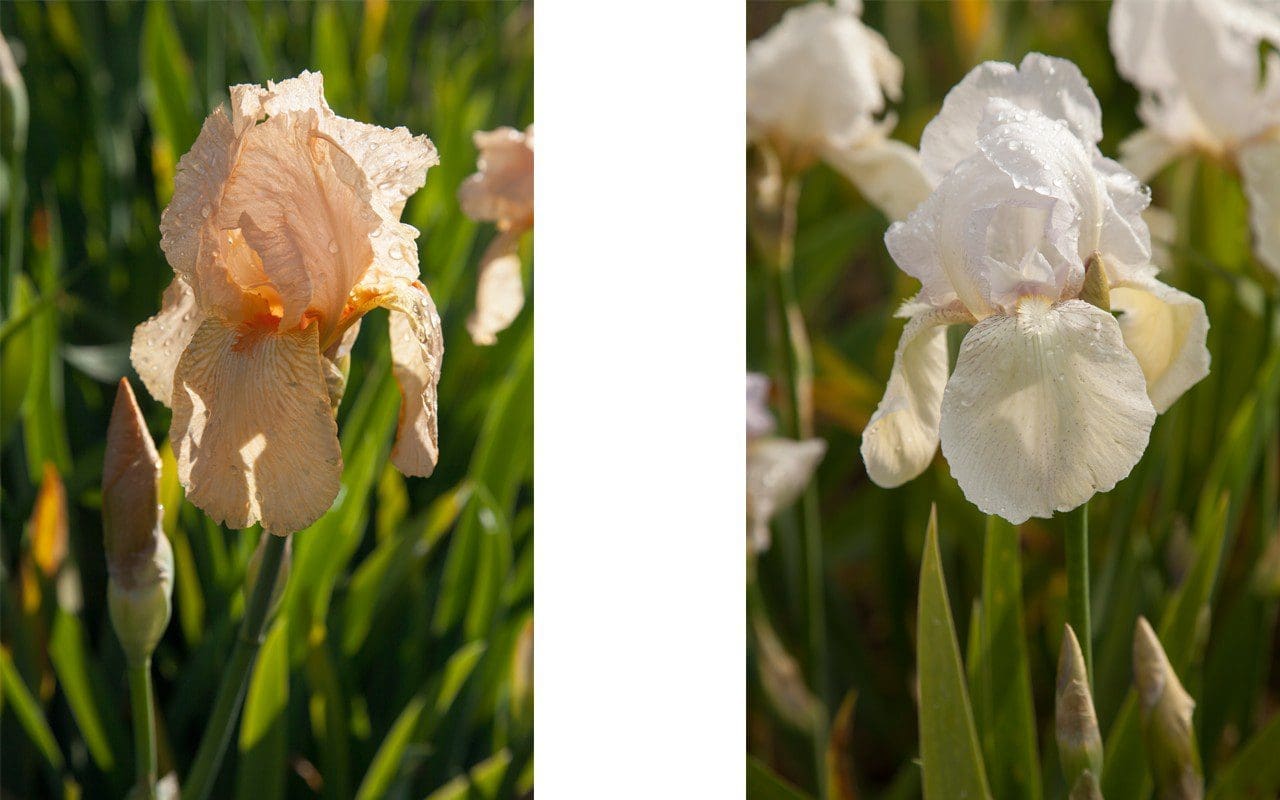 Iris ‘Benton Strathmore’ and Iris ‘Benton Opal’
Iris ‘Benton Strathmore’ and Iris ‘Benton Opal’
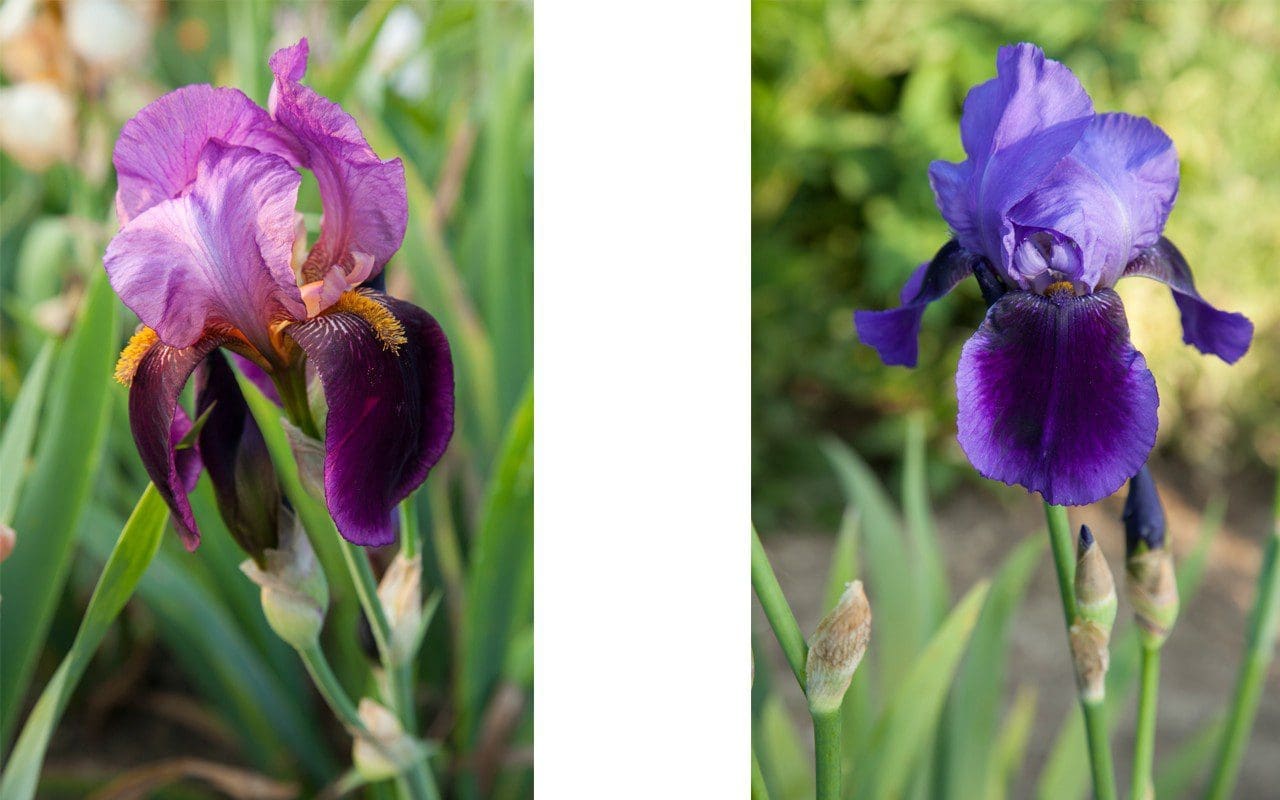 Iris ‘Benton Storrington’ and Iris ‘Benton Nigel’
Iris ‘Benton Storrington’ and Iris ‘Benton Nigel’
I have been planning for this moment for several years, as the trial garden is now in the process of being liberated to make way for the remainder of the new garden. I have deliberately not included the bearded iris in the new plantings, partly because they are very hard to use in combination, needing full sun at the base and no competition, plus they are altogether too captivating and attention-grabbing when they are in flower in June. The chosen few have been found a special place against the hot wall behind the herb garden, where they can have all the attention they want. All being well, they will thrive there with the radiated heat from the blockwork and I plan for there to be no companions for this is the way that the germanica iris usually fail, as they are lost to competition.
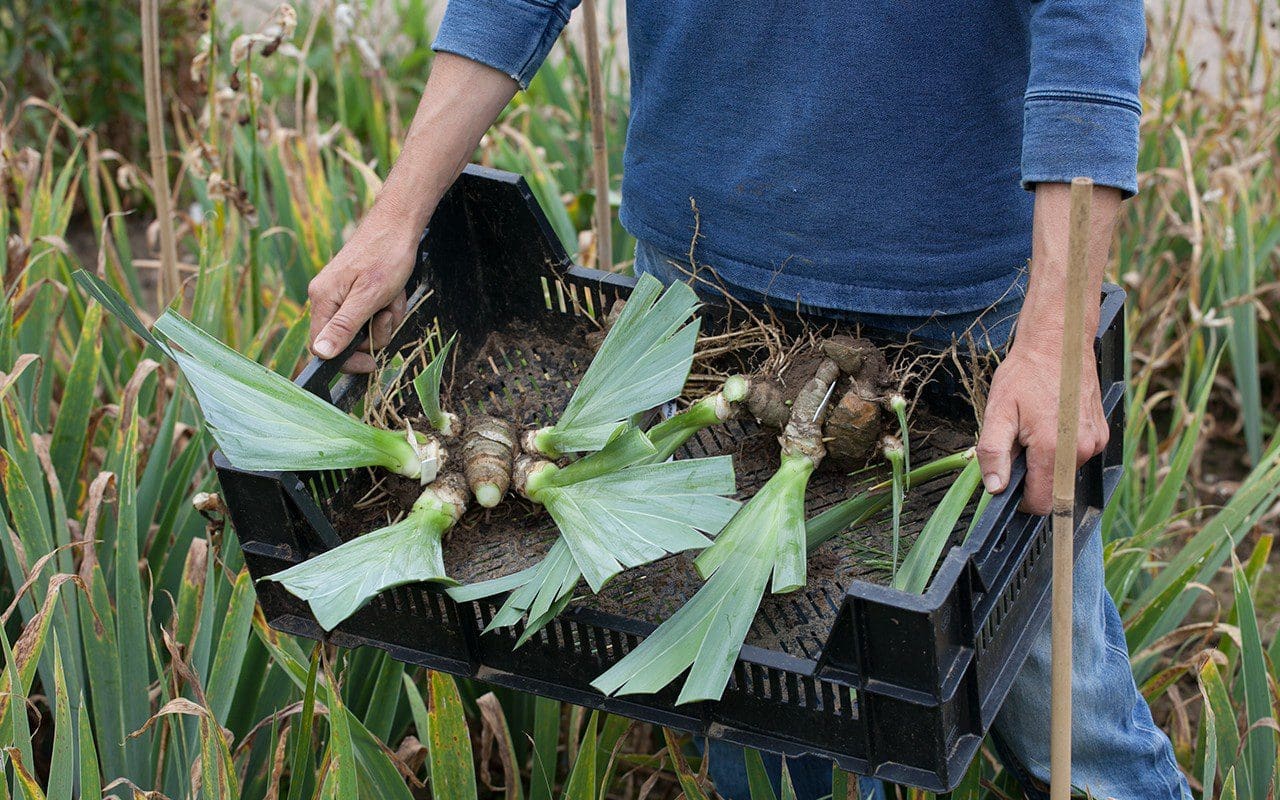 Iris rhizomes after lifting, splitting and trimming
Iris rhizomes after lifting, splitting and trimming
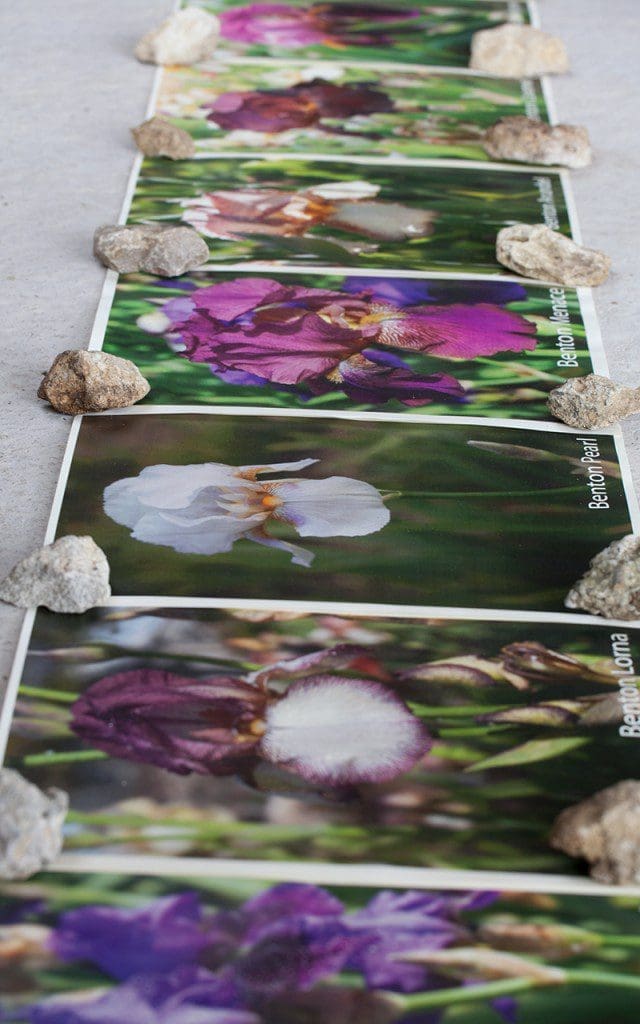 Print outs helped fine-tune the colour combinations of the Benton iris before planting
Print outs helped fine-tune the colour combinations of the Benton iris before planting
I lifted them in early July, as soon as they started to show signs of going into their period of summer dormancy. Splits were separated from the main clump with a carefully aimed border fork separating a healthy rhizome, with two fans of foliage and the energy in it to make good growth as soon as they start back into life later in the summer. The leaves were cut back into a fan in text-book fashion to reduce transpiration and to clean up any diseased foliage. The Bentons are well known for their health, but all the germanicas go into their scruffiest period in the middle of summer and the clean up feels good. The plants were replanted, the rhizomes facing south with the fan of foliage behind, like holidaymakers sunning themselves in deckchairs, to harvest all the light there is going. Our ground being damp in winter, I drew the limestone chippings from the path around their collars to help with free drainage and give them the best start at the beginning of this new and refined chapter.
Words: Dan Pearson / Photographs: Huw Morgan
Published 22 July 2017 Winter is a productive season here in Britain. The weather rarely closes in to stop us for more than a few days and, with the garden in stasis, there is room to think and plan and do. The few truly dormant weeks saw us clearing another fallen tree in January, logging the wood for the winter and stacking the brush into piles (main image) that will become home to the creatures, lichens and fungi that like the protection and decay. If we have snow the tracks to and from the stacks advertise their occupancy but, where the surrounding grass gives way to the shelter within, there are already signs of the annual cleavers that climb into their cages and clothe them in summer.
Before the hedges were cut we harvested a few bundles of hazel to provide twiggy support for broad beans and sturdy poles for the sweet peas and climbing beans. They are a welcome bounty and the result of cutting the hedges every other year to allow them time to flower and berry. Two years is just enough time for the oldest and strongest hazel in the hedge to push out a good length of twiggery. Next year, whilst the hedges are growing back, I will coppice a couple of our freestanding hazel. It is hugely gratifying to be self-sufficient for plant supports for the garden. Whilst they are regenerating the hazel stumps are protected from the nibbling of deer with woven cages of offcuts.
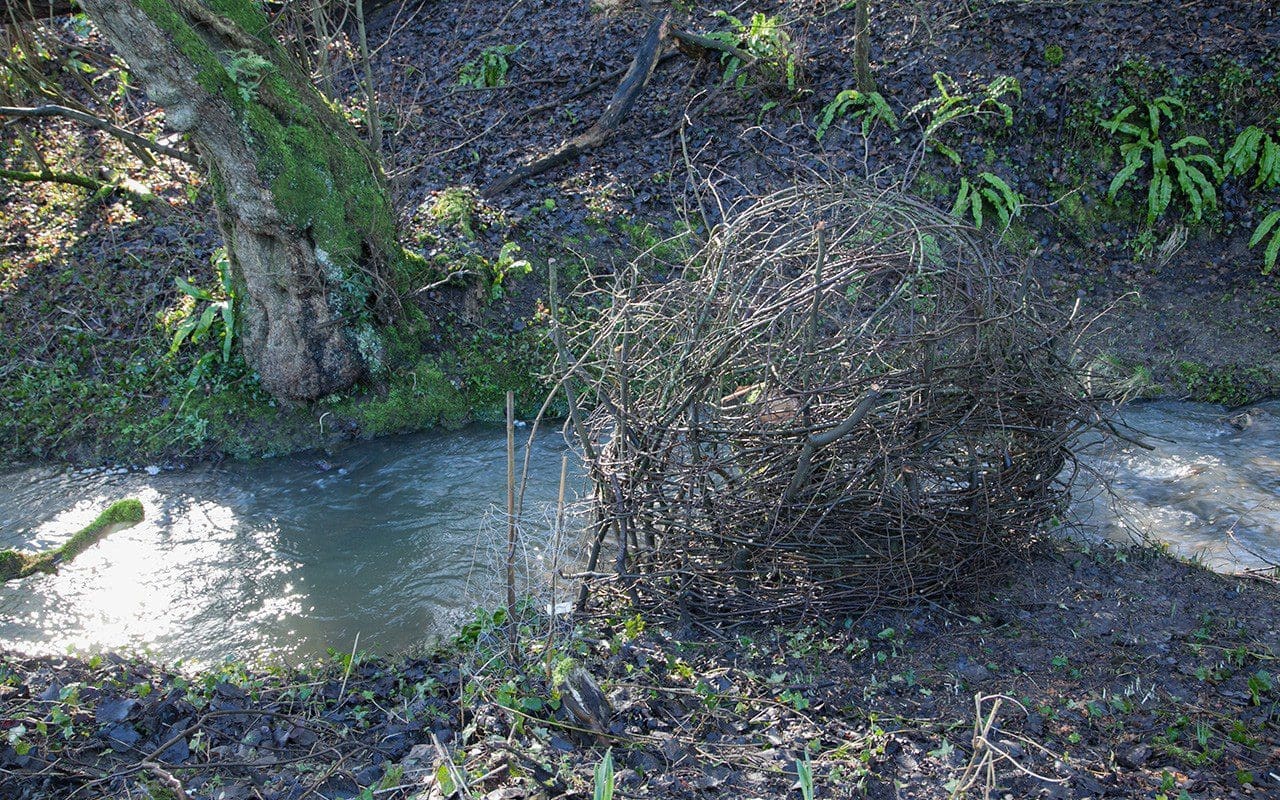 A coppiced hazel protected from deer by a cage of offcuts
A coppiced hazel protected from deer by a cage of offcuts
 Hazel poles harvested from the hedgerows
Hazel poles harvested from the hedgerows
Though we complain here about the winter’s duration, I cannot help but compare these few fairly benign months to the harsh conditions at my
project in Hokkaido. There the gardeners have to leave the frozen landscape in search of work whilst the garden lies beneath deep snow until late April. The rush of tasks to either side – in preparation for the slumber and then the great surge of activity in spring – is palpable in head gardener Midori’s communications. Meanwhile, here we are free to dig and prune and plant. What luxury it is to get things in order with these few weeks of down time on our hands.
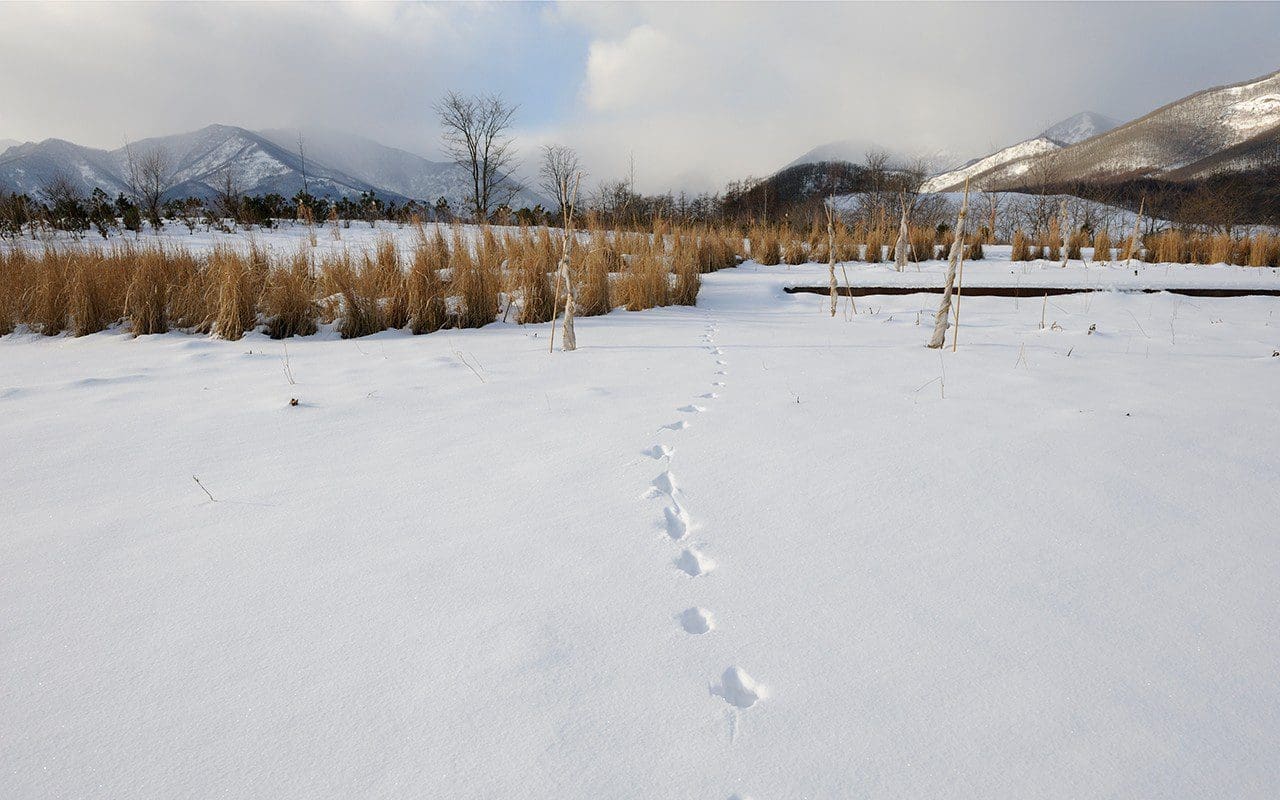 The Meadow Garden at the Tokachi Millennium Forest in Hokkaido is under snow until late April. Photograph: Syogo Oizumi
The Meadow Garden at the Tokachi Millennium Forest in Hokkaido is under snow until late April. Photograph: Syogo Oizumi
It has been a busy winter for I am readying myself to plant up the first sections of the
new garden that was landscaped last summer. This time last year the same ground lay fallow with a green manure crop protecting it from the leaching effect of rain and to keep it ‘clean’ from the cold season weeds that colonise whenever there is a window of growing opportunity. The winter rye grew thick and lush, except where the diggers had tracked over the ground during the previous summer’s building works, where it grew sickly and thinly, indicating that something needed addressing before going any further.
When we started the winter dig, the problem that the rye had mapped became clear. Not far beneath the surface the soil had become anaerobic, starved of air by the compaction and with the tell-tale foetid smell as you turned it. The organic matter in the soil had turned grey where the bacteria were unable to function without oxygen and the water ran off and not through as it should. Turned roughly at the front end of winter, like a ploughed field, the frost has since teased and broken this layer down and the air has made its way back into the topsoil to keep it alive and functioning. Though it is still too wet to walk across, you can see that the winter freeze and thaw has worked its magic and that, as soon as we have a dry spell, it will knock out nicely like a good crumble mix, in readiness for planting.
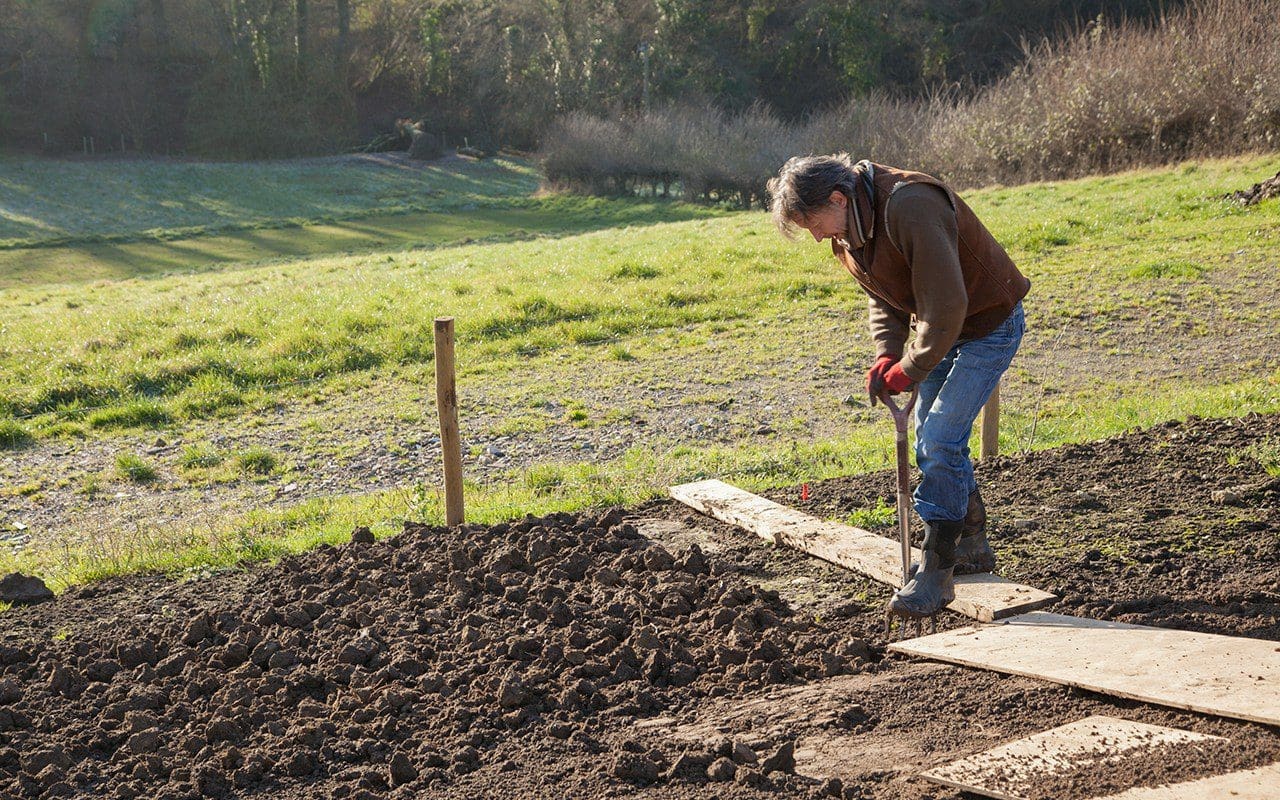 Digging over the compacted soil, working from boards to prevent further compaction
Digging over the compacted soil, working from boards to prevent further compaction
Time taken in preparation is never time wasted and it is a good feeling to give new plants the best possible start in their new positions. As the soil was previously pasture and we have the advantage of heartiness, the organic content is already good enough, so we will not be digging in compost this year. I want the plants to grow lean and strong so that they can cope with the openness and exposure of the site rather than be overly cosseted or encouraged to grow too fast and fleshy. Organic matter will slowly be introduced after planting in the form of a weed-free compost mulch to keep the germinating weeds down and to protect the soil from desiccation. The earthworms, which are now free to travel through the previously compacted ground, will pull the mulch into the soil and do the work for me.
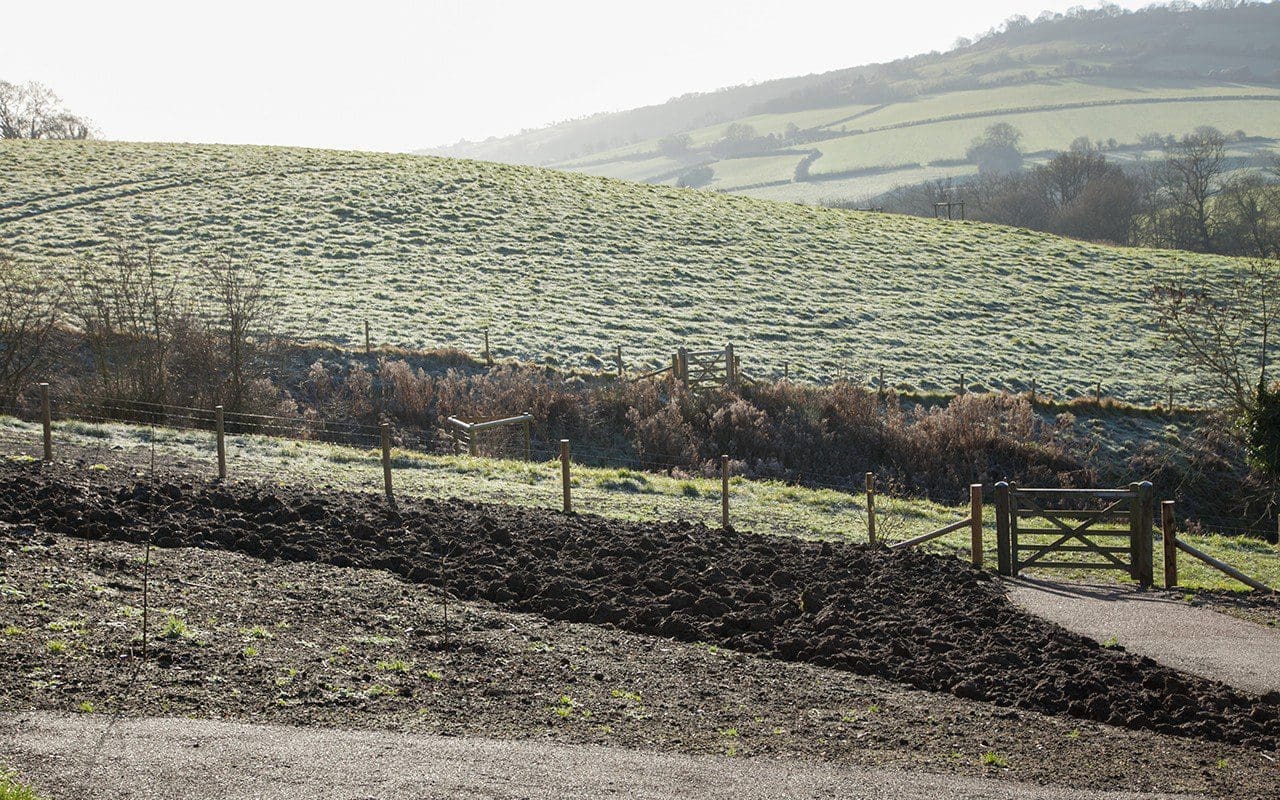 One of the planting beds in the new garden half dug over to allow the frost to do its work
One of the planting beds in the new garden half dug over to allow the frost to do its work
In the vegetable beds, where we have been working the soil and demanding more from it, the organic matter is replenished annually to keep the fertility levels up. Our own home made compost is dug in now that the heaps are up and running. The compost is left a whole year to break down so that one bay is quietly rotting whilst the other is being filled. If I had more time, or a forklift to turn it, I would have a better, more friable compost in just six months. Turning allows air into the heap and the uncomposted material moved to the centre heats the heap more efficiently to help to kill weed seeds.
 One of the compost bays
One of the compost bays
My year old compost is only really good for turning in as it springs a fine crop of seedlings from the hay we rake off the banks in the summer. There are also rashes of garden plants; euphorbias that were thrown on the heap after their heads were cut in seed, bronze fennel, Shirley poppies, phacelia and a host of other plants that have lain dormant. No matter. Since the heaps sit directly on the earth the compost is full of worms, and this can only be good for the soil and its future aeration. You can see the soil in the garden getting better and darker, more friable and more retentive with every year that passes. A reward for the hard work and payback for the bounty that we take from it.
Words: Dan Pearson / Photographs: Huw Morgan We have had a remarkable fortnight. August at its best with heat in the sun and long cloudless days. Cracks have opened up in the ground that are large enough to slide my fingers into and the garden has responded accordingly with fruit ripening and plants racing to set seed.
It has been the perfect time to gather, with a daily vigil to check on ripening and harvesting just as the seed is ready to disperse. It is a yearly ritual, which I can trace back over thirty years to my black opium poppies. I may have missed a year or two of scattering them onto new ground to ensure that I have them the following year, but I have always had their seed in store, just in case. The seed is a currency of sorts and I can always depend upon the next generation if I have some in my pocket.
Saving and sowing seed is rewarding on many levels. First, it is free, and mostly plentiful. A pinch goes a long way, but sometimes you need more than a pinch to make an impression. Secondly, raising plants from seed gives you a full and rounded understanding of how a plant develops and what it needs at each of its stages of life to thrive. A seed-raised plant has a different value, for you have not skipped a step. It will have been in your care from the get-go and may also come with associated stories that trace directly back to its provenance; what it grew with and where, or who passed the seed on and why.
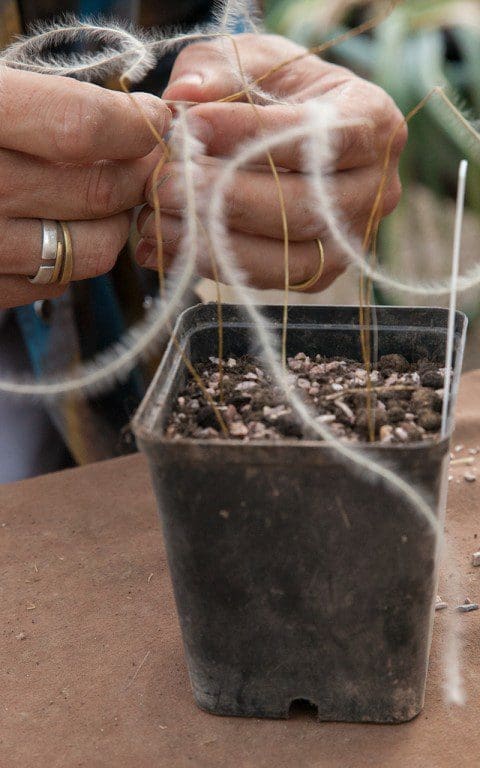 The seed of Stipa barbata is like the point of a dart and drills itself into the soil vertically when the long, silvery awn twists and contracts above it
The seed of Stipa barbata is like the point of a dart and drills itself into the soil vertically when the long, silvery awn twists and contracts above it
Seed-raised plants are prone to variability and just occasionally you might find that a form has something superior to its parent: more vigour, a difference in flower colour or the potential of resistance to disease. Ash-dieback is an issue that we are all dreading as it works its way across the country, but there is surely hope in the fact that ash are such prolific seeders, that maybe there will be a seedling, or a percentage of seedlings, that are naturally resistant.
Not all seed comes true and this has its advantages as well as its disappointments. I keep my
Tagetes patula and
Tagetes ‘Cinnabar’ at opposite ends of the kitchen garden, as they are notoriously promiscuous. If they cross-pollinate the deep, velvet-red of the ‘Cinnabar’ will be tainted, its crosses in the next generation slashed with yellow, with neither the electric tangerine colour of the pure species nor the richness of the named hybrid. It is good to keep them pure.
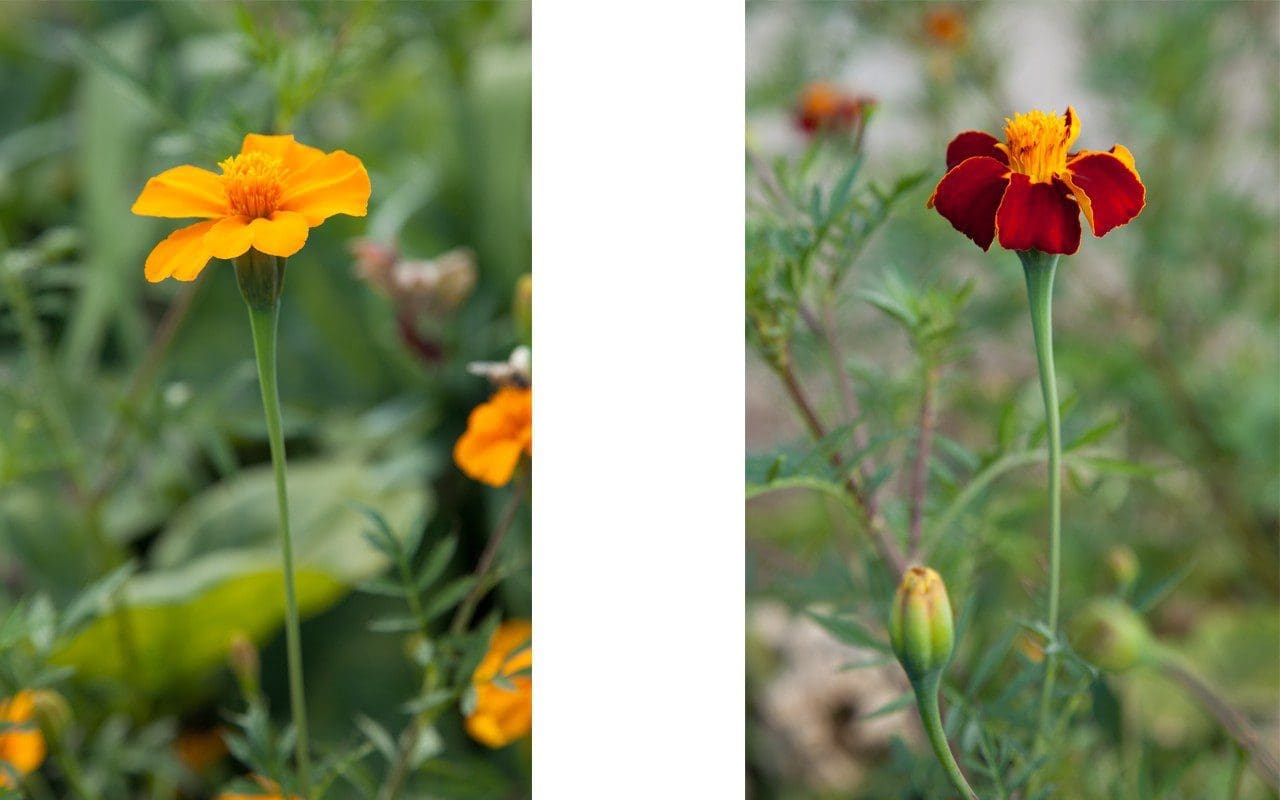 Tagetes patula (left) and Tagetes ‘Cinnabar’ (right)
Tagetes patula (left) and Tagetes ‘Cinnabar’ (right)
In contrast the range of amethyst colours found in
Camassia leichtlinii ‘Avon’s Stellar Hybrids’ are the delightful result of natural variance, coming in the darkest blue-purple and fading through grey-lilac and pink to off-white. For the last couple of years I have been harvesting seed from mine to build up stocks. The seed is prolific and I have broadcast some on the wildflower banks below the kitchen garden in the hope that they will find a window and establish in the sward. I have also sown a pot full of seed for a more controlled result. When sown fresh they come easily the following spring. A pot sown each year should provide me with the quantities that I need to make an impression. After sowing they should take three to four years to flower and it will be exciting to see the natural variability in the seedlings.
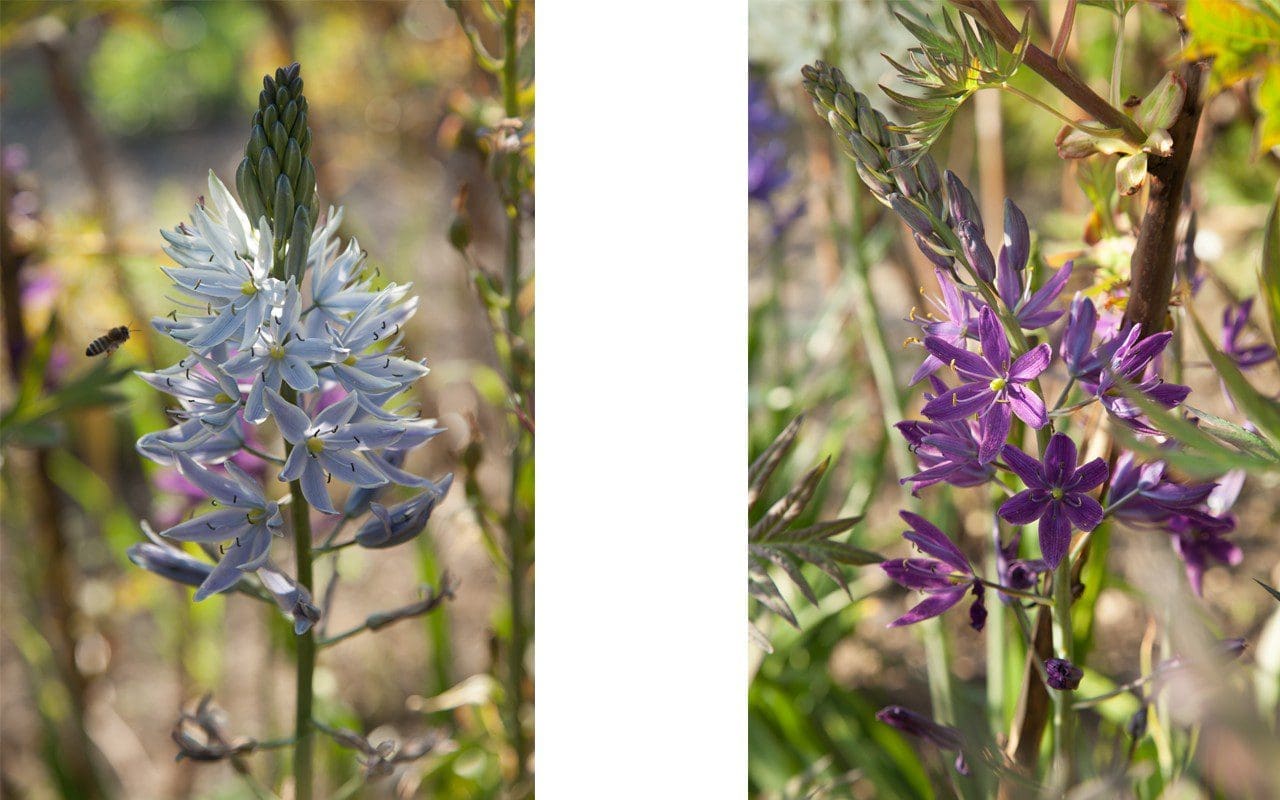 Camassia leichtlinii ‘Avon’s Stellar Hybrids’ showing the natural colour variation in the flowers
Camassia leichtlinii ‘Avon’s Stellar Hybrids’ showing the natural colour variation in the flowers
Self-sown seedlings are an indicator that you have found a place that suits a plant. This is my ultimate goal in the garden here: to work with the conditions and what the plants favour and for self-seeding to create a ‘blur’ in some of the plantings that allows them to take on their own direction.
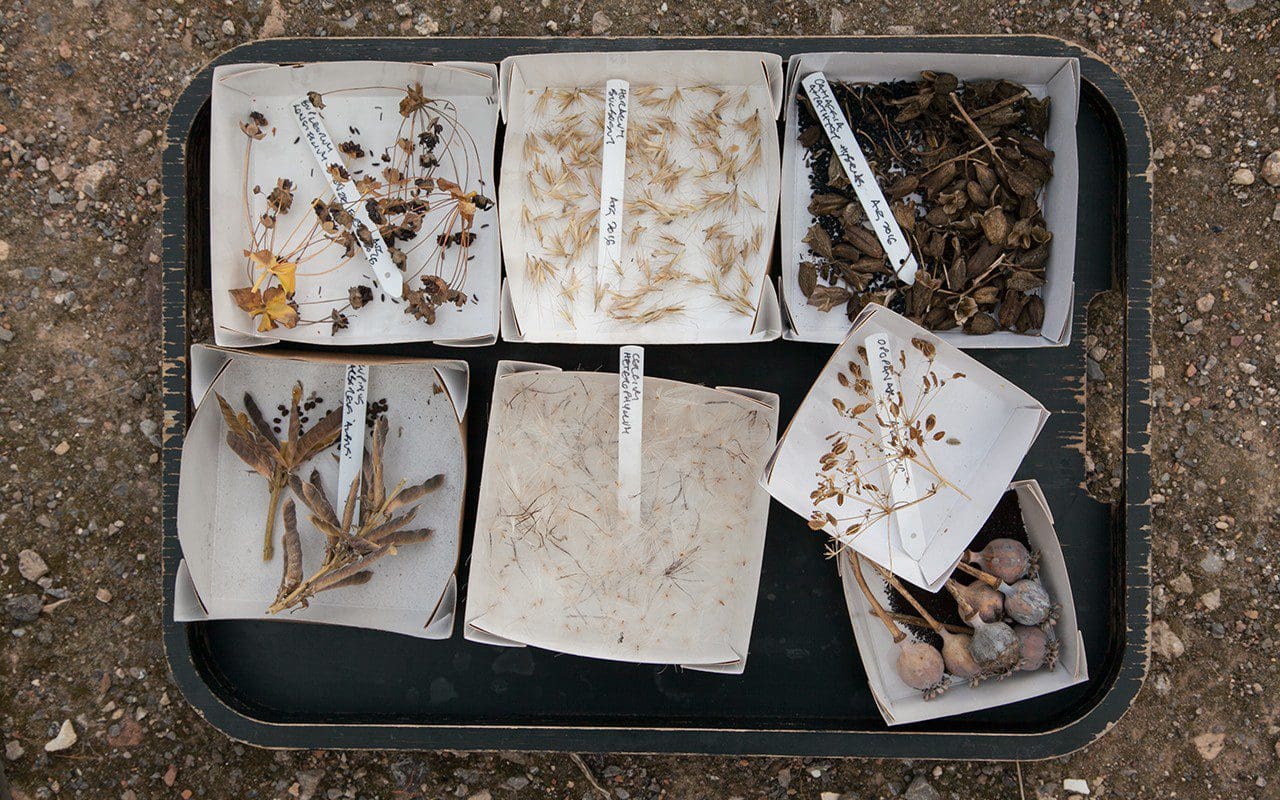 Seed collected this summer
Seed collected this summer
The seed gathering started last month, each new collection stored in a reserve of pie boxes which make the perfect receptacles. The boxes are left open on a sunny windowsill until the seed is thoroughly dry and then labelled for clarity. Not all seed is for keeping. Umbellifers, for instance, and plants from the family
Ranunculaceae are best sown fresh as the seed degrades rapidly. Sown now, and depending upon the species, they will sit in their pots until spring and have their dormancy broken by the stratification of frost. Peonies may take up to two years to germinate. The first year will see roots forming and nothing above ground, the second spring will give you the first leaves, so sometimes patience is important. Other seed such as scabious and
Succisa come up almost immediately, so that they are past the seedling stage in order to overwinter as youngsters and get away quickly in the spring.
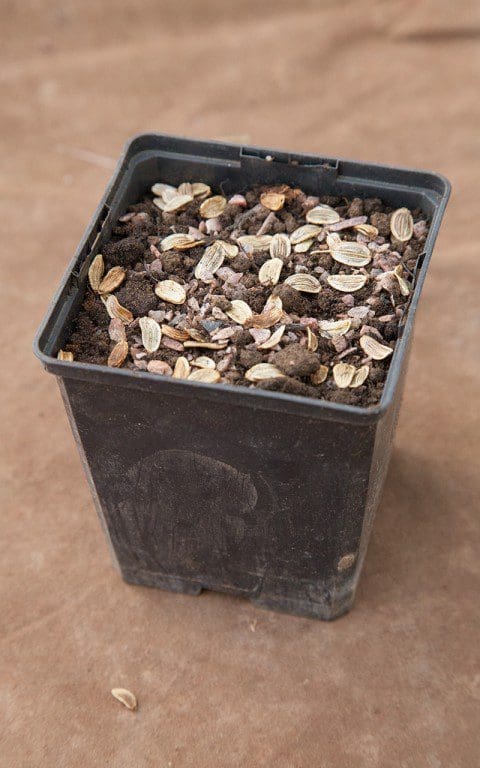 Seed of umbellifers, such as Opopanax chironium, must be sown fresh
Seed of umbellifers, such as Opopanax chironium, must be sown fresh
I like to sow in a gritty mix for maximum drainage and find that if the seedlings have to search for moisture they develop a better root system. Seed is scattered as lightly as possible across the surface so that the seedlings have room to develop their first true leaves before transplanting. I like to top-dress the seed with horticultural grit, again for drainage and also the advantage of protecting the seedlings from the soft underbellies of slugs and snails. The pots are stored in the controlled environment of the cold-frame where I can keep an eye on watering, and so that they do not lie wet in winter. Seed for keeping, such as the annual tagetes, will be kept dry in Tupperware in the back of the fridge to slow their degradation and brought to life again next spring with the summer stretching ahead of them.
 The first of this year’s sowings ready for the cold-frame
Words: Dan Pearson / Photographs: Huw Morgan
The first of this year’s sowings ready for the cold-frame
Words: Dan Pearson / Photographs: Huw Morgan We are sorry but the page you are looking
for does not exist.
You could return to the
homepage
 The iris trial bed in full flower in early June with the Bentons in the front
The Benton iris were bred by the artist and plantsman Cedric Morris at his home Benton End in Suffolk. Between 1934 and 1960 he raised thousands of bearded iris from seed, selecting some of the first pink, peach and yellow varieties that were widely acclaimed at The Chelsea Flower Show. Regularly growing as many as a thousand seedlings a year he named around 90 varieties, the greater majority of which have been lost to time as they went out of fashion or were left behind and then, as gardens changed hands, overwhelmed or their provenance forgotten. As timing would have it, Sarah Cook, the previous head gardener at Sissinghurst, had also fallen under their spell and had made it her mission to pull the lost collection together. She teamed up with Howards Nurseries and together they mounted one of the best stands in the Great Pavilion at the 2015 Chelsea Flower Show. Thanks to Sarah and her tireless hunt and research, twenty five or so are now available again and her quest to find still more is ongoing.
The iris trial bed in full flower in early June with the Bentons in the front
The Benton iris were bred by the artist and plantsman Cedric Morris at his home Benton End in Suffolk. Between 1934 and 1960 he raised thousands of bearded iris from seed, selecting some of the first pink, peach and yellow varieties that were widely acclaimed at The Chelsea Flower Show. Regularly growing as many as a thousand seedlings a year he named around 90 varieties, the greater majority of which have been lost to time as they went out of fashion or were left behind and then, as gardens changed hands, overwhelmed or their provenance forgotten. As timing would have it, Sarah Cook, the previous head gardener at Sissinghurst, had also fallen under their spell and had made it her mission to pull the lost collection together. She teamed up with Howards Nurseries and together they mounted one of the best stands in the Great Pavilion at the 2015 Chelsea Flower Show. Thanks to Sarah and her tireless hunt and research, twenty five or so are now available again and her quest to find still more is ongoing.
 Iris ‘Benton Pearl’ and Iris ‘Benton Olive’
Iris ‘Benton Pearl’ and Iris ‘Benton Olive’
 Iris ‘Benton Deidre’ and Iris ‘Benton Arundel’
I would love to have met Morris, for he obviously had an incredible eye and nose for a flower with poise, grace and perfect balance, despite its complexity. Thanks to his eye, I have now been able to strip the trial back to my true favourites, which include 20 of his selections and just a handful of others that feel right alongside them; chestnut brown ‘Kent Pride’ was bred in the ’50’s and has the same period feel, while the straw yellow ‘Glen Ellen’ is as graceful in form and unusual in its colouring. The only blues I have kept are pale and refined; the small-flowered picotee, ‘Madame Chereau’ and the ice-blue and white ‘Nassak’. Of the purples ‘Demi-deuil’ almost looks like a species iris with small, dark-veined flowers, while the truly almost-black ‘Anvil of Darkness’ was always a keeper, because to my eye no other iris has such depth of colour combined with such a light and refined flower form.
Iris ‘Benton Deidre’ and Iris ‘Benton Arundel’
I would love to have met Morris, for he obviously had an incredible eye and nose for a flower with poise, grace and perfect balance, despite its complexity. Thanks to his eye, I have now been able to strip the trial back to my true favourites, which include 20 of his selections and just a handful of others that feel right alongside them; chestnut brown ‘Kent Pride’ was bred in the ’50’s and has the same period feel, while the straw yellow ‘Glen Ellen’ is as graceful in form and unusual in its colouring. The only blues I have kept are pale and refined; the small-flowered picotee, ‘Madame Chereau’ and the ice-blue and white ‘Nassak’. Of the purples ‘Demi-deuil’ almost looks like a species iris with small, dark-veined flowers, while the truly almost-black ‘Anvil of Darkness’ was always a keeper, because to my eye no other iris has such depth of colour combined with such a light and refined flower form.
 Iris ‘Benton Nutkin’ and Iris ‘Benton Caramel’
Iris ‘Benton Nutkin’ and Iris ‘Benton Caramel’
 Iris ‘Benton Susan’ and Iris ‘Benton Duff’
The Bentons have their own particular beauty which is hard to put your finger on, but you know it when you see it. With more elongated flowers and space between the falls they have an ethereal, stately quality. There is a bruised, sophisticated complexity of colour, which conjures another period and you can see is the result of an artist’s eye; picotees in shades of plum, mauve and pink, silver grey, mother-of-pearl white, primrose yellow, true apricot, rich chocolate brown and papal purple. You completely trust in Morris’s eye when you see them and his choices were so particular that you can almost feel what it might have been like to know the man himself.
Iris ‘Benton Susan’ and Iris ‘Benton Duff’
The Bentons have their own particular beauty which is hard to put your finger on, but you know it when you see it. With more elongated flowers and space between the falls they have an ethereal, stately quality. There is a bruised, sophisticated complexity of colour, which conjures another period and you can see is the result of an artist’s eye; picotees in shades of plum, mauve and pink, silver grey, mother-of-pearl white, primrose yellow, true apricot, rich chocolate brown and papal purple. You completely trust in Morris’s eye when you see them and his choices were so particular that you can almost feel what it might have been like to know the man himself.
 Iris ‘Benton Strathmore’ and Iris ‘Benton Opal’
Iris ‘Benton Strathmore’ and Iris ‘Benton Opal’
 Iris ‘Benton Storrington’ and Iris ‘Benton Nigel’
I have been planning for this moment for several years, as the trial garden is now in the process of being liberated to make way for the remainder of the new garden. I have deliberately not included the bearded iris in the new plantings, partly because they are very hard to use in combination, needing full sun at the base and no competition, plus they are altogether too captivating and attention-grabbing when they are in flower in June. The chosen few have been found a special place against the hot wall behind the herb garden, where they can have all the attention they want. All being well, they will thrive there with the radiated heat from the blockwork and I plan for there to be no companions for this is the way that the germanica iris usually fail, as they are lost to competition.
Iris ‘Benton Storrington’ and Iris ‘Benton Nigel’
I have been planning for this moment for several years, as the trial garden is now in the process of being liberated to make way for the remainder of the new garden. I have deliberately not included the bearded iris in the new plantings, partly because they are very hard to use in combination, needing full sun at the base and no competition, plus they are altogether too captivating and attention-grabbing when they are in flower in June. The chosen few have been found a special place against the hot wall behind the herb garden, where they can have all the attention they want. All being well, they will thrive there with the radiated heat from the blockwork and I plan for there to be no companions for this is the way that the germanica iris usually fail, as they are lost to competition.
 Iris rhizomes after lifting, splitting and trimming
Iris rhizomes after lifting, splitting and trimming
 Print outs helped fine-tune the colour combinations of the Benton iris before planting
I lifted them in early July, as soon as they started to show signs of going into their period of summer dormancy. Splits were separated from the main clump with a carefully aimed border fork separating a healthy rhizome, with two fans of foliage and the energy in it to make good growth as soon as they start back into life later in the summer. The leaves were cut back into a fan in text-book fashion to reduce transpiration and to clean up any diseased foliage. The Bentons are well known for their health, but all the germanicas go into their scruffiest period in the middle of summer and the clean up feels good. The plants were replanted, the rhizomes facing south with the fan of foliage behind, like holidaymakers sunning themselves in deckchairs, to harvest all the light there is going. Our ground being damp in winter, I drew the limestone chippings from the path around their collars to help with free drainage and give them the best start at the beginning of this new and refined chapter.
Words: Dan Pearson / Photographs: Huw Morgan
Published 22 July 2017 Winter is a productive season here in Britain. The weather rarely closes in to stop us for more than a few days and, with the garden in stasis, there is room to think and plan and do. The few truly dormant weeks saw us clearing another fallen tree in January, logging the wood for the winter and stacking the brush into piles (main image) that will become home to the creatures, lichens and fungi that like the protection and decay. If we have snow the tracks to and from the stacks advertise their occupancy but, where the surrounding grass gives way to the shelter within, there are already signs of the annual cleavers that climb into their cages and clothe them in summer.
Before the hedges were cut we harvested a few bundles of hazel to provide twiggy support for broad beans and sturdy poles for the sweet peas and climbing beans. They are a welcome bounty and the result of cutting the hedges every other year to allow them time to flower and berry. Two years is just enough time for the oldest and strongest hazel in the hedge to push out a good length of twiggery. Next year, whilst the hedges are growing back, I will coppice a couple of our freestanding hazel. It is hugely gratifying to be self-sufficient for plant supports for the garden. Whilst they are regenerating the hazel stumps are protected from the nibbling of deer with woven cages of offcuts.
Print outs helped fine-tune the colour combinations of the Benton iris before planting
I lifted them in early July, as soon as they started to show signs of going into their period of summer dormancy. Splits were separated from the main clump with a carefully aimed border fork separating a healthy rhizome, with two fans of foliage and the energy in it to make good growth as soon as they start back into life later in the summer. The leaves were cut back into a fan in text-book fashion to reduce transpiration and to clean up any diseased foliage. The Bentons are well known for their health, but all the germanicas go into their scruffiest period in the middle of summer and the clean up feels good. The plants were replanted, the rhizomes facing south with the fan of foliage behind, like holidaymakers sunning themselves in deckchairs, to harvest all the light there is going. Our ground being damp in winter, I drew the limestone chippings from the path around their collars to help with free drainage and give them the best start at the beginning of this new and refined chapter.
Words: Dan Pearson / Photographs: Huw Morgan
Published 22 July 2017 Winter is a productive season here in Britain. The weather rarely closes in to stop us for more than a few days and, with the garden in stasis, there is room to think and plan and do. The few truly dormant weeks saw us clearing another fallen tree in January, logging the wood for the winter and stacking the brush into piles (main image) that will become home to the creatures, lichens and fungi that like the protection and decay. If we have snow the tracks to and from the stacks advertise their occupancy but, where the surrounding grass gives way to the shelter within, there are already signs of the annual cleavers that climb into their cages and clothe them in summer.
Before the hedges were cut we harvested a few bundles of hazel to provide twiggy support for broad beans and sturdy poles for the sweet peas and climbing beans. They are a welcome bounty and the result of cutting the hedges every other year to allow them time to flower and berry. Two years is just enough time for the oldest and strongest hazel in the hedge to push out a good length of twiggery. Next year, whilst the hedges are growing back, I will coppice a couple of our freestanding hazel. It is hugely gratifying to be self-sufficient for plant supports for the garden. Whilst they are regenerating the hazel stumps are protected from the nibbling of deer with woven cages of offcuts.
 A coppiced hazel protected from deer by a cage of offcuts
A coppiced hazel protected from deer by a cage of offcuts
 Hazel poles harvested from the hedgerows
Though we complain here about the winter’s duration, I cannot help but compare these few fairly benign months to the harsh conditions at my project in Hokkaido. There the gardeners have to leave the frozen landscape in search of work whilst the garden lies beneath deep snow until late April. The rush of tasks to either side – in preparation for the slumber and then the great surge of activity in spring – is palpable in head gardener Midori’s communications. Meanwhile, here we are free to dig and prune and plant. What luxury it is to get things in order with these few weeks of down time on our hands.
Hazel poles harvested from the hedgerows
Though we complain here about the winter’s duration, I cannot help but compare these few fairly benign months to the harsh conditions at my project in Hokkaido. There the gardeners have to leave the frozen landscape in search of work whilst the garden lies beneath deep snow until late April. The rush of tasks to either side – in preparation for the slumber and then the great surge of activity in spring – is palpable in head gardener Midori’s communications. Meanwhile, here we are free to dig and prune and plant. What luxury it is to get things in order with these few weeks of down time on our hands.
 The Meadow Garden at the Tokachi Millennium Forest in Hokkaido is under snow until late April. Photograph: Syogo Oizumi
It has been a busy winter for I am readying myself to plant up the first sections of the new garden that was landscaped last summer. This time last year the same ground lay fallow with a green manure crop protecting it from the leaching effect of rain and to keep it ‘clean’ from the cold season weeds that colonise whenever there is a window of growing opportunity. The winter rye grew thick and lush, except where the diggers had tracked over the ground during the previous summer’s building works, where it grew sickly and thinly, indicating that something needed addressing before going any further.
When we started the winter dig, the problem that the rye had mapped became clear. Not far beneath the surface the soil had become anaerobic, starved of air by the compaction and with the tell-tale foetid smell as you turned it. The organic matter in the soil had turned grey where the bacteria were unable to function without oxygen and the water ran off and not through as it should. Turned roughly at the front end of winter, like a ploughed field, the frost has since teased and broken this layer down and the air has made its way back into the topsoil to keep it alive and functioning. Though it is still too wet to walk across, you can see that the winter freeze and thaw has worked its magic and that, as soon as we have a dry spell, it will knock out nicely like a good crumble mix, in readiness for planting.
The Meadow Garden at the Tokachi Millennium Forest in Hokkaido is under snow until late April. Photograph: Syogo Oizumi
It has been a busy winter for I am readying myself to plant up the first sections of the new garden that was landscaped last summer. This time last year the same ground lay fallow with a green manure crop protecting it from the leaching effect of rain and to keep it ‘clean’ from the cold season weeds that colonise whenever there is a window of growing opportunity. The winter rye grew thick and lush, except where the diggers had tracked over the ground during the previous summer’s building works, where it grew sickly and thinly, indicating that something needed addressing before going any further.
When we started the winter dig, the problem that the rye had mapped became clear. Not far beneath the surface the soil had become anaerobic, starved of air by the compaction and with the tell-tale foetid smell as you turned it. The organic matter in the soil had turned grey where the bacteria were unable to function without oxygen and the water ran off and not through as it should. Turned roughly at the front end of winter, like a ploughed field, the frost has since teased and broken this layer down and the air has made its way back into the topsoil to keep it alive and functioning. Though it is still too wet to walk across, you can see that the winter freeze and thaw has worked its magic and that, as soon as we have a dry spell, it will knock out nicely like a good crumble mix, in readiness for planting.
 Digging over the compacted soil, working from boards to prevent further compaction
Time taken in preparation is never time wasted and it is a good feeling to give new plants the best possible start in their new positions. As the soil was previously pasture and we have the advantage of heartiness, the organic content is already good enough, so we will not be digging in compost this year. I want the plants to grow lean and strong so that they can cope with the openness and exposure of the site rather than be overly cosseted or encouraged to grow too fast and fleshy. Organic matter will slowly be introduced after planting in the form of a weed-free compost mulch to keep the germinating weeds down and to protect the soil from desiccation. The earthworms, which are now free to travel through the previously compacted ground, will pull the mulch into the soil and do the work for me.
Digging over the compacted soil, working from boards to prevent further compaction
Time taken in preparation is never time wasted and it is a good feeling to give new plants the best possible start in their new positions. As the soil was previously pasture and we have the advantage of heartiness, the organic content is already good enough, so we will not be digging in compost this year. I want the plants to grow lean and strong so that they can cope with the openness and exposure of the site rather than be overly cosseted or encouraged to grow too fast and fleshy. Organic matter will slowly be introduced after planting in the form of a weed-free compost mulch to keep the germinating weeds down and to protect the soil from desiccation. The earthworms, which are now free to travel through the previously compacted ground, will pull the mulch into the soil and do the work for me.
 One of the planting beds in the new garden half dug over to allow the frost to do its work
In the vegetable beds, where we have been working the soil and demanding more from it, the organic matter is replenished annually to keep the fertility levels up. Our own home made compost is dug in now that the heaps are up and running. The compost is left a whole year to break down so that one bay is quietly rotting whilst the other is being filled. If I had more time, or a forklift to turn it, I would have a better, more friable compost in just six months. Turning allows air into the heap and the uncomposted material moved to the centre heats the heap more efficiently to help to kill weed seeds.
One of the planting beds in the new garden half dug over to allow the frost to do its work
In the vegetable beds, where we have been working the soil and demanding more from it, the organic matter is replenished annually to keep the fertility levels up. Our own home made compost is dug in now that the heaps are up and running. The compost is left a whole year to break down so that one bay is quietly rotting whilst the other is being filled. If I had more time, or a forklift to turn it, I would have a better, more friable compost in just six months. Turning allows air into the heap and the uncomposted material moved to the centre heats the heap more efficiently to help to kill weed seeds.
 One of the compost bays
My year old compost is only really good for turning in as it springs a fine crop of seedlings from the hay we rake off the banks in the summer. There are also rashes of garden plants; euphorbias that were thrown on the heap after their heads were cut in seed, bronze fennel, Shirley poppies, phacelia and a host of other plants that have lain dormant. No matter. Since the heaps sit directly on the earth the compost is full of worms, and this can only be good for the soil and its future aeration. You can see the soil in the garden getting better and darker, more friable and more retentive with every year that passes. A reward for the hard work and payback for the bounty that we take from it.
Words: Dan Pearson / Photographs: Huw Morgan We have had a remarkable fortnight. August at its best with heat in the sun and long cloudless days. Cracks have opened up in the ground that are large enough to slide my fingers into and the garden has responded accordingly with fruit ripening and plants racing to set seed.
It has been the perfect time to gather, with a daily vigil to check on ripening and harvesting just as the seed is ready to disperse. It is a yearly ritual, which I can trace back over thirty years to my black opium poppies. I may have missed a year or two of scattering them onto new ground to ensure that I have them the following year, but I have always had their seed in store, just in case. The seed is a currency of sorts and I can always depend upon the next generation if I have some in my pocket.
Saving and sowing seed is rewarding on many levels. First, it is free, and mostly plentiful. A pinch goes a long way, but sometimes you need more than a pinch to make an impression. Secondly, raising plants from seed gives you a full and rounded understanding of how a plant develops and what it needs at each of its stages of life to thrive. A seed-raised plant has a different value, for you have not skipped a step. It will have been in your care from the get-go and may also come with associated stories that trace directly back to its provenance; what it grew with and where, or who passed the seed on and why.
One of the compost bays
My year old compost is only really good for turning in as it springs a fine crop of seedlings from the hay we rake off the banks in the summer. There are also rashes of garden plants; euphorbias that were thrown on the heap after their heads were cut in seed, bronze fennel, Shirley poppies, phacelia and a host of other plants that have lain dormant. No matter. Since the heaps sit directly on the earth the compost is full of worms, and this can only be good for the soil and its future aeration. You can see the soil in the garden getting better and darker, more friable and more retentive with every year that passes. A reward for the hard work and payback for the bounty that we take from it.
Words: Dan Pearson / Photographs: Huw Morgan We have had a remarkable fortnight. August at its best with heat in the sun and long cloudless days. Cracks have opened up in the ground that are large enough to slide my fingers into and the garden has responded accordingly with fruit ripening and plants racing to set seed.
It has been the perfect time to gather, with a daily vigil to check on ripening and harvesting just as the seed is ready to disperse. It is a yearly ritual, which I can trace back over thirty years to my black opium poppies. I may have missed a year or two of scattering them onto new ground to ensure that I have them the following year, but I have always had their seed in store, just in case. The seed is a currency of sorts and I can always depend upon the next generation if I have some in my pocket.
Saving and sowing seed is rewarding on many levels. First, it is free, and mostly plentiful. A pinch goes a long way, but sometimes you need more than a pinch to make an impression. Secondly, raising plants from seed gives you a full and rounded understanding of how a plant develops and what it needs at each of its stages of life to thrive. A seed-raised plant has a different value, for you have not skipped a step. It will have been in your care from the get-go and may also come with associated stories that trace directly back to its provenance; what it grew with and where, or who passed the seed on and why.
 The seed of Stipa barbata is like the point of a dart and drills itself into the soil vertically when the long, silvery awn twists and contracts above it
Seed-raised plants are prone to variability and just occasionally you might find that a form has something superior to its parent: more vigour, a difference in flower colour or the potential of resistance to disease. Ash-dieback is an issue that we are all dreading as it works its way across the country, but there is surely hope in the fact that ash are such prolific seeders, that maybe there will be a seedling, or a percentage of seedlings, that are naturally resistant.
Not all seed comes true and this has its advantages as well as its disappointments. I keep my Tagetes patula and Tagetes ‘Cinnabar’ at opposite ends of the kitchen garden, as they are notoriously promiscuous. If they cross-pollinate the deep, velvet-red of the ‘Cinnabar’ will be tainted, its crosses in the next generation slashed with yellow, with neither the electric tangerine colour of the pure species nor the richness of the named hybrid. It is good to keep them pure.
The seed of Stipa barbata is like the point of a dart and drills itself into the soil vertically when the long, silvery awn twists and contracts above it
Seed-raised plants are prone to variability and just occasionally you might find that a form has something superior to its parent: more vigour, a difference in flower colour or the potential of resistance to disease. Ash-dieback is an issue that we are all dreading as it works its way across the country, but there is surely hope in the fact that ash are such prolific seeders, that maybe there will be a seedling, or a percentage of seedlings, that are naturally resistant.
Not all seed comes true and this has its advantages as well as its disappointments. I keep my Tagetes patula and Tagetes ‘Cinnabar’ at opposite ends of the kitchen garden, as they are notoriously promiscuous. If they cross-pollinate the deep, velvet-red of the ‘Cinnabar’ will be tainted, its crosses in the next generation slashed with yellow, with neither the electric tangerine colour of the pure species nor the richness of the named hybrid. It is good to keep them pure.
 Tagetes patula (left) and Tagetes ‘Cinnabar’ (right)
In contrast the range of amethyst colours found in Camassia leichtlinii ‘Avon’s Stellar Hybrids’ are the delightful result of natural variance, coming in the darkest blue-purple and fading through grey-lilac and pink to off-white. For the last couple of years I have been harvesting seed from mine to build up stocks. The seed is prolific and I have broadcast some on the wildflower banks below the kitchen garden in the hope that they will find a window and establish in the sward. I have also sown a pot full of seed for a more controlled result. When sown fresh they come easily the following spring. A pot sown each year should provide me with the quantities that I need to make an impression. After sowing they should take three to four years to flower and it will be exciting to see the natural variability in the seedlings.
Tagetes patula (left) and Tagetes ‘Cinnabar’ (right)
In contrast the range of amethyst colours found in Camassia leichtlinii ‘Avon’s Stellar Hybrids’ are the delightful result of natural variance, coming in the darkest blue-purple and fading through grey-lilac and pink to off-white. For the last couple of years I have been harvesting seed from mine to build up stocks. The seed is prolific and I have broadcast some on the wildflower banks below the kitchen garden in the hope that they will find a window and establish in the sward. I have also sown a pot full of seed for a more controlled result. When sown fresh they come easily the following spring. A pot sown each year should provide me with the quantities that I need to make an impression. After sowing they should take three to four years to flower and it will be exciting to see the natural variability in the seedlings.
 Camassia leichtlinii ‘Avon’s Stellar Hybrids’ showing the natural colour variation in the flowers
Self-sown seedlings are an indicator that you have found a place that suits a plant. This is my ultimate goal in the garden here: to work with the conditions and what the plants favour and for self-seeding to create a ‘blur’ in some of the plantings that allows them to take on their own direction.
Camassia leichtlinii ‘Avon’s Stellar Hybrids’ showing the natural colour variation in the flowers
Self-sown seedlings are an indicator that you have found a place that suits a plant. This is my ultimate goal in the garden here: to work with the conditions and what the plants favour and for self-seeding to create a ‘blur’ in some of the plantings that allows them to take on their own direction.
 Seed collected this summer
The seed gathering started last month, each new collection stored in a reserve of pie boxes which make the perfect receptacles. The boxes are left open on a sunny windowsill until the seed is thoroughly dry and then labelled for clarity. Not all seed is for keeping. Umbellifers, for instance, and plants from the family Ranunculaceae are best sown fresh as the seed degrades rapidly. Sown now, and depending upon the species, they will sit in their pots until spring and have their dormancy broken by the stratification of frost. Peonies may take up to two years to germinate. The first year will see roots forming and nothing above ground, the second spring will give you the first leaves, so sometimes patience is important. Other seed such as scabious and Succisa come up almost immediately, so that they are past the seedling stage in order to overwinter as youngsters and get away quickly in the spring.
Seed collected this summer
The seed gathering started last month, each new collection stored in a reserve of pie boxes which make the perfect receptacles. The boxes are left open on a sunny windowsill until the seed is thoroughly dry and then labelled for clarity. Not all seed is for keeping. Umbellifers, for instance, and plants from the family Ranunculaceae are best sown fresh as the seed degrades rapidly. Sown now, and depending upon the species, they will sit in their pots until spring and have their dormancy broken by the stratification of frost. Peonies may take up to two years to germinate. The first year will see roots forming and nothing above ground, the second spring will give you the first leaves, so sometimes patience is important. Other seed such as scabious and Succisa come up almost immediately, so that they are past the seedling stage in order to overwinter as youngsters and get away quickly in the spring.
 Seed of umbellifers, such as Opopanax chironium, must be sown fresh
I like to sow in a gritty mix for maximum drainage and find that if the seedlings have to search for moisture they develop a better root system. Seed is scattered as lightly as possible across the surface so that the seedlings have room to develop their first true leaves before transplanting. I like to top-dress the seed with horticultural grit, again for drainage and also the advantage of protecting the seedlings from the soft underbellies of slugs and snails. The pots are stored in the controlled environment of the cold-frame where I can keep an eye on watering, and so that they do not lie wet in winter. Seed for keeping, such as the annual tagetes, will be kept dry in Tupperware in the back of the fridge to slow their degradation and brought to life again next spring with the summer stretching ahead of them.
Seed of umbellifers, such as Opopanax chironium, must be sown fresh
I like to sow in a gritty mix for maximum drainage and find that if the seedlings have to search for moisture they develop a better root system. Seed is scattered as lightly as possible across the surface so that the seedlings have room to develop their first true leaves before transplanting. I like to top-dress the seed with horticultural grit, again for drainage and also the advantage of protecting the seedlings from the soft underbellies of slugs and snails. The pots are stored in the controlled environment of the cold-frame where I can keep an eye on watering, and so that they do not lie wet in winter. Seed for keeping, such as the annual tagetes, will be kept dry in Tupperware in the back of the fridge to slow their degradation and brought to life again next spring with the summer stretching ahead of them.
 The first of this year’s sowings ready for the cold-frame
Words: Dan Pearson / Photographs: Huw Morgan We are sorry but the page you are looking
for does not exist.
You could return to the homepage
The first of this year’s sowings ready for the cold-frame
Words: Dan Pearson / Photographs: Huw Morgan We are sorry but the page you are looking
for does not exist.
You could return to the homepage